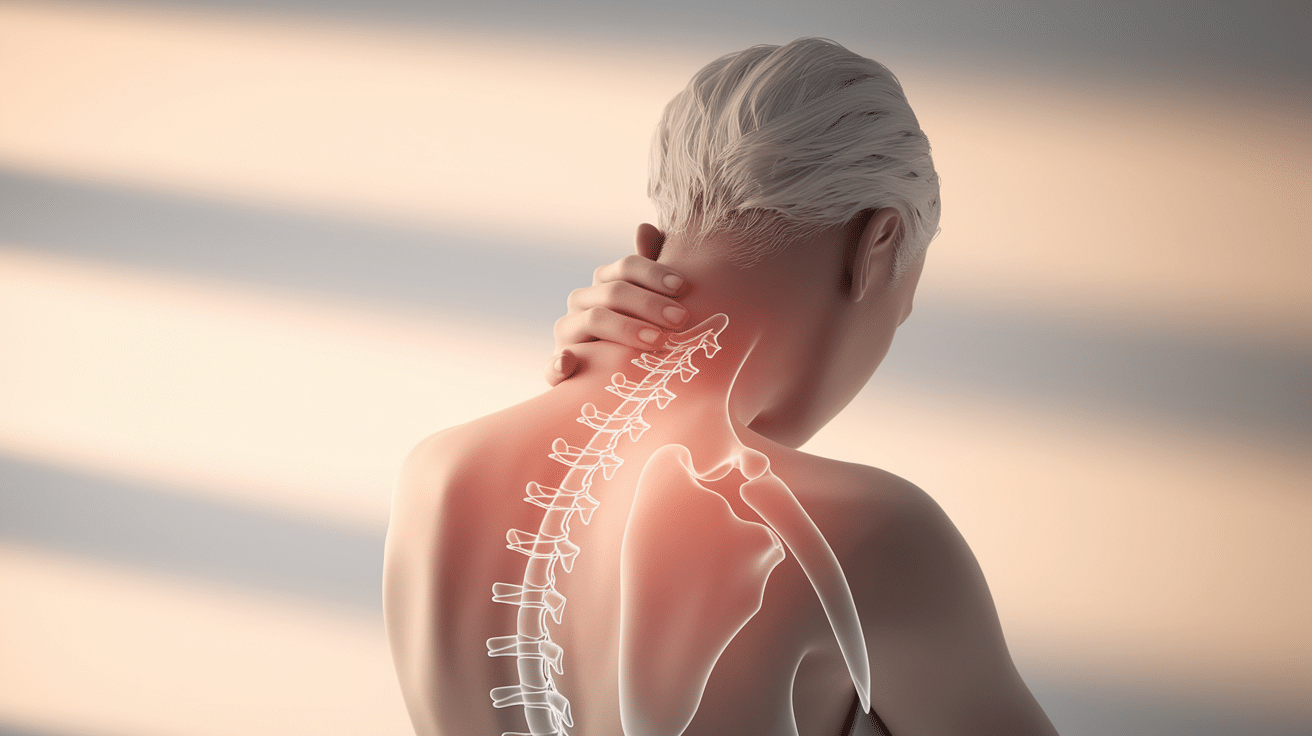Does your neck hurt so much that simple tasks like checking your blind spot while driving become painful?
You’re experiencing what millions of people deal with every day. Persistent neck discomfort can disrupt normal life and make basic activities challenging.
Most people call it neck pain, but doctors use a specific term called cervicalgia.
Understanding the cervicalgia definition helps you recognize this common condition that affects the cervical spine, muscles, and surrounding tissues. From computer work and stress to injuries and aging, various factors can trigger this painful condition.
This blog will teach you everything about cervicalgia. You’ll learn what it means, what causes it, how to recognize serious symptoms, and most importantly, how to treat and prevent it effectively.
What Is Cervicalgia?
Cervicalgia definition in simple terms, is neck pain.
The word comes from “cervical” (relating to the neck) and “algia” (meaning pain). Doctors use this medical term to describe any discomfort, aching, or stiffness in the neck area.
In clinical terms, cervicalgia refers to pain originating from the cervical spine region, which includes the seven vertebrae (C1-C7) that make up your neck.
This condition can affect muscles, ligaments, nerves, or the vertebrae themselves.
Basic Neck Anatomy
Your cervical spine consists of seven small bones called vertebrae. These bones stack on top of each other and are labeled C1 through C7, starting from the top.
Key structures include:
- Vertebrae: The seven neck bones that protect your spinal cord
- Intervertebral discs: Soft cushions between each vertebra
- Spinal nerves: Eight pairs of nerves that branch out from the spinal cord
- Muscles and ligaments: Support structures that help move and stabilize the neck
The cervical spine supports your head’s weight and allows for a wide range of motion. This flexibility, while beneficial, also makes the neck more prone to injury and pain.
When any of these structures become damaged, inflamed, or strained, cervicalgia can occur. The pain may stay in the neck area or spread to the shoulders, arms, or even cause headaches.
Cervicalgia Classification by Duration
Medical professionals group cervicalgia into three main categories based on how long the pain lasts.
| Type | Duration | Characteristics | Treatment Focus |
|---|---|---|---|
| Acute Cervicalgia | Less than 4 weeks | Often starts suddenly, usually from injury or muscle strain | Rest, pain relief, basic care |
| Subacute Cervicalgia | 4 to 12 weeks | May develop from untreated acute pain | More focused treatment is needed |
| Chronic Cervicalgia | More than 12 weeks | Can be constant or intermittent, impacts daily life | Long-term management required |
Cervicalgia Symptoms and Warning Signs
The cervicalgia definition includes various symptoms that can affect your daily life. Recognizing these signs helps you know when to seek medical help.
Common Cervicalgia Symptoms
The most common symptoms include localized neck pain that can feel like aching, sharp stabbing, burning, tingling, or muscle spasms.
Many people also experience stiffness that makes it difficult to turn their head, look up or down, or feel “locked” in position.
Another primary symptom is a limited range of motion, where you can’t move your neck freely, making activities like driving particularly challenging.
How Cervicalgia Affects Other Body Parts?
Radiating pain may travel from the neck to the shoulders, arms, hands, or base of the skull. Many people develop headaches that often start at the skull base and move forward, creating tension or pressure sensations.
Some individuals experience muscle weakness in the arms or hands, which typically results from nerve compression in the cervical spine.
When Cervicalgia Requires Emergency Care?
You should seek immediate medical attention if you experience numbness or tingling in your arms or hands that doesn’t go away, fever along with neck pain, recent trauma such as car accidents, falls, or sports injuries, or severe headaches that are different from your usual ones.
Cervicalgia Diagnosis and Treatment
Healthcare providers use systematic approaches to diagnose and treat cervicalgia effectively. Treatment varies based on severity and underlying causes.
Cervicalgia Treatment Options
Home management strategies work well for many cases and include rest and activity modification, heat and cold therapy, and posture improvements.
Simple changes like taking breaks from desk work, using proper neck support while sleeping, and keeping screens at eye level can provide significant relief.
Professional medical treatments become necessary when home care isn’t sufficient. Physical therapy strengthens neck muscles and improves flexibility.
Medications include over-the-counter pain relievers, muscle relaxants, and prescription options for severe cases. Injections may be recommended for persistent pain that doesn’t respond to other treatments.
Timeline for Seeking Medical Care
Understanding the cervicalgia definition includes knowing when to get help:
- Within 24-48 hours: If pain follows an injury or is severe
- After 1 week: If pain doesn’t improve with rest and basic care
- Immediately: For numbness, fever, or severe headaches
Most neck pain resolves within a few days to a week with proper care and treatment. However, don’t ignore persistent or worsening symptoms.
Progressive weakness in arms or hands needs evaluation within a day or two. This could indicate pressure on spinal nerves that requires treatment.
Cervicalgia Diagnosis Process
| Diagnosis Step | What does it involve? | When It’s Used? |
|---|---|---|
| Medical History | The doctor asks about pain onset, triggers, previous injuries, work activities, and other symptoms. | First step for all patients. |
| Physical Examination | Check neck range of motion, test muscle strength, examine posture, test reflexes, and sensation. | All patients during the initial visit. |
| X-rays | Show bone structure and alignment. | When a fracture or structural problems are suspected. |
| MRI | Reveals soft tissues like discs and nerves. | For persistent pain or suspected nerve compression. |
| CT Scans | Provide detailed bone images. | When X-rays need more detail. |
Most cases don’t require immediate imaging. Tests may be ordered if pain persists beyond 4-6 weeks, shows signs of nerve compression, follows significant injury, or worsens despite treatment.
Cervicalgia Causes and Risk Factors
Knowing about cervicalgia helps identify the triggers of the neck pain condition. Several factors can lead to cervicalgia, ranging from everyday activities to serious injuries:
1. Muscle Strain and Poor Posture
Muscle strain happens when neck muscles work too hard or get stretched beyond their normal range. This is one of the most common causes of cervicalgia in today’s world.
Modern lifestyle habits put constant stress on neck muscles and joints. Many people spend hours in positions that strain their cervical spine.
Who’s most at risk: Office workers who sit at desks for long hours, people who frequently use smartphones and tablets, and those who sleep in awkward positions regularly.
2. Injury-Related Causes
Injuries can cause immediate or delayed cervicalgia symptoms. The sudden force or impact can damage muscles, ligaments, nerves, or vertebrae in the neck.
Whiplash from car accidents is the most well-known injury that causes cervicalgia.
Who’s most at risk: Motor vehicle accident victims, contact sport athletes like football and hockey players, and construction workers and manual laborers
3. Age-Related Changes
As we age, our cervical spine naturally undergoes changes that can lead to cervicalgia. These changes are normal but can cause pain and stiffness over time.
The wear and tear on neck structures becomes more noticeable after age 40. Cartilage thins, discs lose flexibility, and bones may develop extra growths.
Who’s most at risk: Adults over 40 years old, people with a family history of arthritis, and those with previous neck injuries or surgeries.
4. Stress and Workplace Factors
Stress causes muscle tension, particularly in the neck and shoulders. When stressed, people unconsciously tighten these muscles, leading to pain and stiffness.
Poor workplace setups can lead to strain over time. Minor setup issues become major problems when repeated daily for months.
Who’s most at risk: High-stress job workers like healthcare and finance professionals, people with poor workplace setups or non-ergonomic furniture, and those experiencing chronic stress or anxiety disorders.
Cervicalgia Prevention
Understanding cervicalgia helps you take steps to prevent neck pain from developing or returning. Simple changes in daily habits can make a significant difference.
- Proper workstation setup: Position your monitor at eye level, use a supportive chair, and take breaks every 30-60 minutes
- Good phone habits: Hold phones with your hand, not your shoulder, and keep devices at eye level when texting
- Correct driving position: Adjust your car seat correctly and keep your head against the headrest
- Regular neck exercises: Do gentle neck rotations and side-to-side stretches daily
- Proper sleep position: Use one supportive pillow and sleep on your back or side, not your stomach
- Stay physically active: Include regular walking, swimming, or yoga in your routine.
- Manage stress: Practice relaxation techniques to prevent tension-related neck pain.
Final Thoughts
Now you have a complete understanding of cervicalgia and its impact on your daily life.
This neck pain condition affects millions, but with the proper knowledge, you can effectively manage and prevent it.
Remember that the cervicalgia definition encompasses more than simple neck stiffness. It includes symptoms that can radiate to your shoulders, arms, and head.
Early recognition of warning signs is crucial for appropriate treatment. Most cases of cervicalgia respond well to conservative treatment. Simple home remedies, proper posture, regular exercise, and stress management often provide significant relief.
However, don’t hesitate to seek professional help when symptoms persist. Your neck health has a direct impact on your quality of life and daily comfort. By applying the prevention strategies discussed, you can take control of your cervicalgia and enjoy pain-free living.
Frequently Asked Questions
Is Cervicalgia Serious?
Most cases improve with basic home care. However, you should seek immediate medical attention if you experience numbness, severe pain, or symptoms lasting over a week.
Is Cervicalgia Considered a Disability?
Cervicalgia is not always a disability, but if it severely limits daily activities or work, it may qualify as one under certain conditions.
How Long Does Cervicalgia Last?
Acute cervicalgia typically resolves within a few days to several weeks with proper rest and care. Chronic cases may require ongoing management and professional treatment.









